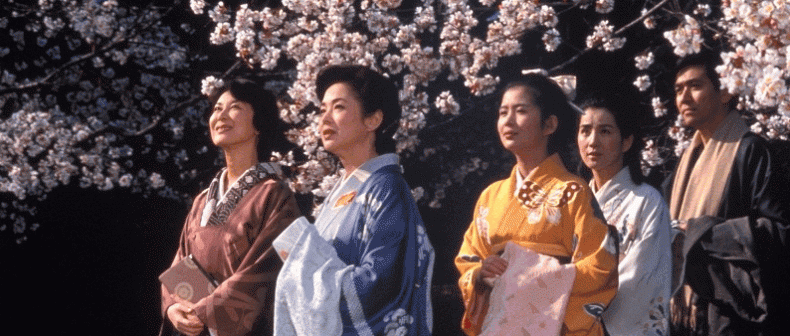
I am not an expert on Japanese cinema. Up until recently, if you mentioned it, my head would fill with images of samurai and Godzilla. Which is why I’m so grateful for Japanese Divas: The Great Actresses of Japanese Cinema’s Golden Age, a series of thirty films now showing at the TIFF Bell Lightbox. The movies, primarily from 1940’s to the 1960’s, cover genres as diverse as domestic dramas and gangster noirs. They gave me a new appreciation for the cinematic legacy of Japan. The films (directed by Kurosawa, Ichikawa, Mizoguchi, and others) capture the country at a moment of massive transition–rebuilding after the devastation of WWII and Hiroshima, the people of Japan had to figure out their new place in a modern world.
The contrast between traditions and modernity is reflected in the films’ costumes. In all of the contemporary-set movies I saw, women wore both Western outfits (as well as hairstyles) alongside traditional Japanese clothing. “Do you remember during the War when we wore pants?” a character asks in Early Summer (1951). After the war was over, Japanese women embraced skirts again (as did their Western counterparts), while also wearing the traditional kimono. The mingling of Dior’s New Look with Japan’s old one makes the style of these films intriguing–a perfect metaphor for the period’s mish mash of values.
The best example is Mikio Naruse’s When a Woman Ascends the Stairs (1960). It stars Hideko Takamine as a Tokyo bar hostess who must be cheerful with male clientele even when her life is unraveling. Due to her lavish lifestyle and the aging family she must support, Takamine is gradually sinking into debt. Some of the other hostesses sell their bodies (the film is refreshingly frank about this), but she wants to maintain her honour. All the hostesses dream of opening up their own bars–their role is somewhere in between geishas and businesswomen. It’s a bleak, but surprisingly sympathetic view of how financially ruinous keeping up appearances can be.
The look and feel of the movie is fantastic. A jazz score compliments shots of fluorescent signs and the women, even when wearing kimonos, sometimes have early-1960’s bouffants. It’s very Mad Men goes to Japan. But kimonos aren’t just a nod to tradition. Because they are worth so much money, they are an investment and status symbol. A woman in Yearning (1964) says that kimonos are a geisha’s secret weapon. I think they’re more like a Louis Vuitton purse. In When a Woman Ascends the Stairs, a hostess works out a scheme in which she buys kimonos on credit and then sells them for cash. It catches up to her, and she ends up accidently poisoning herself.
Kimonos as status symbol turn up in movies you wouldn’t expect. Kenji Mizoguchi’s Ugetsu, a ghost story set in the 16th century, isn’t particularly noteworthy for its costumes. But when the peasant protagonist has a successful day at market, he doesn’t buy his wife jewelry, flowers, or something for around the house. He buys her a kimono.
They play a large role in Kon Ichikawa’s The Makioka Sisters, made in 1983 but set on the eve of WWII. The Jane Austen-ish plot concerns four sisters left without parents. The film demonstrates that it is possible to slam paper sliding doors. Acting as guardians, the two older sisters must find husbands for the two younger ones. The older one, who must wed first, has no interest in suitors. The youngest sister has already run off with a boyfriend once, and shows her rebellious streak by starting a doll-making business and wearing Western clothes (puffy sleeved blouses and plaid skirts). When someone questions where she got an expensive ring, she lies, claiming that she traded her three best kimonos for it. At a time when women didn’t have much (if any) financial independence, kimonos were a valuable commodity and unofficial currency.
A kimono specialist worked on the film to ensure that they fit the period and the actors wore them properly. Through their patterns, shapes, materials, even width of obis, kimonos signify incredibly detailed things about their wearers. The ones used in The Makioka Sisters are gorgeous, with the shimmering texture of gift paper and designs ranging from abstract to flowers, clouds, and animals. There’s a scene in which one of the sisters brings out her collection of old kimonos, hanging them around the house. Their flat, T-shape makes them resemble wall hangings, and the camera lingers over their beauty for no purpose other than to present them as art.
The Makioka Sisters is perhaps too pretty, with scenes of cherry blossoms and falling snow verging on postcard cliché. There’s family drama brewing that sadly never boils over. But there was a scene I absolutely cherished, not for the right reasons. One of the women catches her husband leering at her younger sister while getting dressed. Instead of confronting him, she stumbles into the kitchen in a daze. She picks up a kiwi from the kitchen table and, staring at it with maniacal eyes, squeezes it until its lime green flesh pushes out between her fingers.
Then, she eats it.
From The Makioka Sisters, I also learned that in Japanese society, when a family is prominent enough, men marry into it and the women keep their names. The Makiokas were once a wealthy family, but their fortune has shrunk. The sisters have never gotten over the decision of one of the husbands to sell the family business. “Times are changing,” he says with exasperation. Set in 1938, on the eve of massive change, the family business symbolizes tradition and the old Japan quickly disappearing.
It’s not treated as important in the movie, and I only discovered what the family business entailed while reading reviews afterwards. The Makiokas sold kimonos, of course.
Japanese Divas: The Great Actresses of Japanese Cinema’s Golden Age continues until March 30th. See the schedule of films here.
____
Max Mosher writes about style for Toronto Standard. You can follow him on Twitter at @max_mosher_.
For more, follow us on Twitter @TorontoStandard or subscribe to our newsletter.














